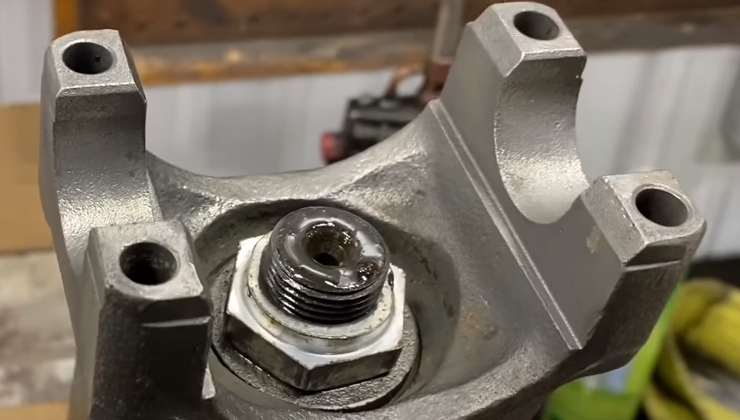The GM 10 bolt rear differential is a popular option that has been used in a wide variety of vehicles for decades. However, to ensure optimal performance and longevity of your rear differential, it’s essential to pay attention to the pinion preload. Pinion preload refers to the amount of force or tension applied to the pinion bearings in the differential, and setting it correctly is crucial to reduce gear noise, wear, and overheating.
In this article, we will explore everything you need to know about GM 10 bolt pinion preload, including why it’s important, how to measure and set it, common issues, and helpful tips. So, whether you are a seasoned mechanic or a DIY enthusiast, read on to learn how to set it like a pro.
Contents
What is GM 10 Bolt Pinion Preload?
When it comes to rear differentials, pinion preload is a crucial aspect of ensuring that the gears are set up correctly and function as intended. The GM 10 bolt pinion preload specifically refers to the amount of force or tension applied to the pinion bearings in a GM 10 bolt rear differential. This preload helps to reduce excess clearance between the gears, which in turn reduces noise, vibration, and wear.
Why is Pinion Preload Important?
Proper pinion preload is critical for optimal performance and longevity of the rear differential. If the preload is too low, the gears can move around too much, leading to excessive wear and noise. On the other hand, if the preload is too high, it can cause the bearings to overheat and ultimately fail. In either case, the result is an expensive and time-consuming repair.
How to Measure GM 10 Bolt Pinion Preload
Measuring requires a few specialized tools, including a dial indicator, torque wrench, and bearing puller. Here are the steps involved:
- Remove the differential cover and drain the oil.
- Remove the bolt that secures the pinion yoke to the pinion shaft.
- Use a bearing puller to remove the pinion shaft and bearings from the differential case.
- Clean the bearings and the pinion shaft.
- Install the bearings and the pinion shaft back into the differential case.
- Install the pinion nut and tighten it to the specified torque.
- Using the dial indicator, measure the amount of force required to rotate the pinion. This measurement is known as the pinion rotating torque.
- Compare the pinion rotating torque to the manufacturer’s specifications. If the torque is too low, adjust the pinion nut until the proper preload is achieved.
Setting GM 10 Bolt Pinion Preload
Once you have measured the pinion preload, it’s time to set it. To do so, follow these steps:
- Remove the pinion nut and washer.
- Install shims onto the pinion gear shaft. The number of shims required will depend on the measured pinion rotating torque.
- Reinstall the pinion nut and washer.
- Tighten the pinion nut to the specified torque while checking the pinion rotating torque. Continue tightening the pinion nut until the desired preload is achieved.
- Once the desired preload is achieved, check the pinion rotating torque one final time to ensure that it falls within the manufacturer’s specifications.
Tips for Setting GM 10 Bolt Pinion Preload
Here are some helpful tips to keep in mind when setting:
- Always refer to the manufacturer’s specifications for the correct pinion preload.
- Use high-quality tools and equipment to ensure accurate measurements.
- When setting preload, start with a slightly lower preload and work your way up until the desired preload is achieved.
- Double-check the pinion rotating torque after the final preload adjustment to ensure that it falls within the manufacturer’s specifications.
- Always use new shims when setting pinion preload.
Common GM 10 Bolt Pinion Preload Issues
Improper pinion preload can lead to a variety of issues, including:
- Excessive gear noise.
- Premature gear wear.
- Overheated bearings.
- Bearing failure.
Frequently Asked Questions
Here are some 10 Bolt Pinion Preload FAQs –
Q: What is the ideal pinion preload for a GM 10 bolt differential?
A: The ideal pinion preload will vary depending on the specific application and manufacturer’s specifications. Always refer to the manufacturer’s guidelines when setting pinion preload.
Q: What happens if pinion preload is too high?
A: If pinion preload is too high, it can cause the bearings to overheat and ultimately fail.
Q: Can I reuse the old pinion shims when setting pinion preload?
A: No, it’s not recommended to reuse old shims. New shims should be used to ensure proper
Conclusion
Setting the correct GM 10 bolt pinion preload is a critical aspect of maintaining a properly functioning rear differential. While it may seem daunting at first, with the right tools, equipment, and guidance, it’s a task that can be accomplished by the experienced DIY mechanic. Properly setting pinion preload can help reduce gear noise, extend the life of your differential, and ultimately save you time and money in the long run.
